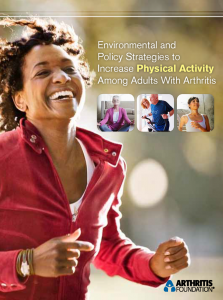About the Guide
This Physical Activity Implementation Guide is designed to engage a broad array of agencies and organizations as partners in establishing environmental and policy strategies for increasing physical activity among adults with arthritis.
Regular physical activity is important for all adults and those with arthritis are no exception. Physical activity has been proven to decrease pain, delay the onset of disability, improve physical functioning, mood, and independence, and enhance quality of life, aerobic capacity and muscle strength. Despite these significant benefits, adults with arthritis have higher rates of physical inactivity than those without arthritis.1
Arthritis affects 58.5 million adults and is the most common cause of disability in the United States.2 Currently, more than 23.7 percent of U.S. adults have arthritis.2 If current trends continue, an estimated 78.4 million Americans will have doctor-diagnosed arthritis by 2040.3
The Arthritis Foundation aims to reduce by 20% the number of people with arthritis-related physical activity limitations by 2030, preserving the mobility and quality of life of 6 million people. Boosting Physical Activity among Adults with Arthritis is designed to help achieve that objective by engaging agencies and organizations in six key sectors and encouraging partnerships to implement environmental and policy strategies to make regular physical activity institutionalized and sustainable.4
- CDC Physical Activity and Arthritis Overview
- CDC Morbidity and Mortality Weekly Report (MMWR)
- CDC Arthritis-Related Statistics
- CDC Community Health Assessment and Group Evaluation (CHANGE) – Action Guide
(Policy strategies are laws, regulations, rules, protocols, and procedures designed to guide or influence behavior. Environmental strategies are physical, social, or economic factors designed to influence people’s practices and behaviors.)
White Paper: Identifying Relevant Environmental and Policy Strategies to Increase Physical Activity among Adults with Arthritis
Intended Users
This Guide is designed to be useful for professionals and community members working in a variety of sectors who are interested in improving the quality of life for people with arthritis and the other constituents they serve.
- Community and Public Health
- Health Care
- Transportation, Land Use, and Community Design
- Business and Industry
- Park, Recreation, Fitness and Sport
- Mass Media and Communication.
The Guide may also be useful for agencies and organizations specifically charged to serve adults with arthritis, namely Arthritis Foundation chapters and state and local public health departments that coordinate chronic disease programs in their jurisdictions.

